lock INFINITI Q70 HYBRID 2017 Roadside Assistance Guide
[x] Cancel search | Manufacturer: INFINITI, Model Year: 2017, Model line: Q70 HYBRID, Model: INFINITI Q70 HYBRID 2017Pages: 36, PDF Size: 3.94 MB
Page 3 of 36
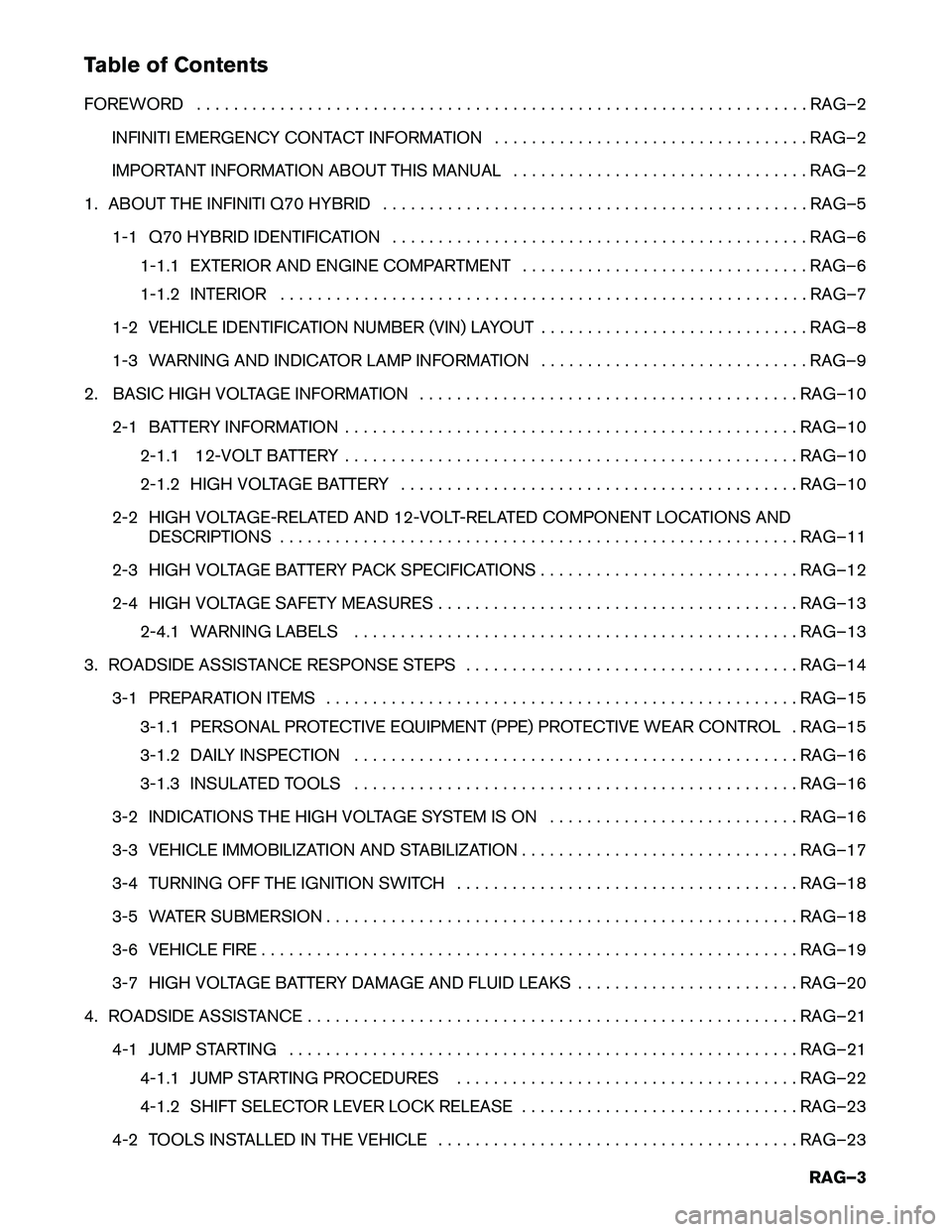
Table of Contents
FOREWORD . . . . . . . . . . . . . . . . . . . . . . . . . . . . . . . . . . . . . . . . . . . . . . . . . .. . . . . . . . . . . . . . . . RAG–2
INFINITI EMERGENCY CONTACT INFORMATION . . . . . . . . . . . . . . . . . . . . . . . . . . . . . . . . . . RAG–2
IMPORTANT INFORMATION ABOUT THIS MANUAL . . . . . . . . . . . . . . . . . . . . . . . . . . . . . . . . RAG–2
1. ABOUT THE INFINITI Q70 HYBRID . . . . . . . . . . . . . . . . . . . . . . . . . . . . . . . . . . . . . . . . . . . . . . RAG–5
1-1 Q70 HYBRID IDENTIFICATION . . . . . . . . . . . . . . . . . . . . . . . . . . . . . . . . . . . . . . . . . . . . . RAG–6 1-1.1 EXTERIOR AND ENGINE COMPARTMENT . . . . . . . . . . . . . . . . . . . . . . . . . . . . . . . RAG–6
1-1.2 INTERIOR . . . . . . . . . . . . . . . . . . . . . . . . . . . . . . . . . . . . . . . . . . . . . . . . . . . . . . . . . RAG–7
1-2 VEHICLE IDENTIFICATION NUMBER (VIN) LAYOUT . . . . . . . . . . . . . . . . . . . . . . . . . . . . . RAG–8
1-3 WARNING AND INDICATOR LAMP INFORMATION . . . . . . . . . . . . . . . . . . . . . . . . . . . . . RAG–9
2. BASIC HIGH VOLTAGE INFORMATION . . . . . . . . . . . . . . . . . . . . . . . . . . . . . . . . . . . . . . . . . RAG–10
2-1 BATTERY INFORMATION . . . . . . . . . . . . . . . . . . . . . . . . . . . . . . . . . . . . . . . . . . . . . . . . . RAG–10
2-1.1 12-VOLT BATTERY . . . . . . . . . . . . . . . . . . . . . . . . . . . . . . . . . . . . . . . . . . . . . . . . . RAG–10
2-1.2 HIGH VOLTAGE BATTERY . . . . . . . . . . . . . . . . . . . . . . . . . . . . . . . . . . . . . . . . . . . RAG–10
2-2 HIGH VOLTAGE-RELATED AND 12-VOLT-RELATED COMPONENT LOCATIONS AND DESCRIPTIONS . . . . . . . . . . . . . . . . . . . . . . . . . . . . . . . . . . . . . . . . . . . . . . . . . . . . . . . . RAG–11
2-3 HIGH VOLTAGE BATTERY PACK SPECIFICATIONS . . . . . . . . . . . . . . . . . . . . . . . . . . . . RAG–12
2-4 HIGH VOLTAGE SAFETY MEASURES . . . . . . . . . . . . . . . . . . . . . . . . . . . . . . . . . . . . . . . RAG–13 2-4.1 WARNING LABELS . . . . . . . . . . . . . . . . . . . . . . . . . . . . . . . . . . . . . . . . . . . . . . . . RAG–13
3. ROADSIDE ASSISTANCE RESPONSE STEPS . . . . . . . . . . . . . . . . . . . . . . . . . . . . . . . . . . . . RAG–14
3-1 PREPARATION ITEMS . . . . . . . . . . . . . . . . . . . . . . . . . . . . . . . . . . . . . . . . . . . . . . . . . . . RAG–15
3-1.1 PERSONAL PROTECTIVE EQUIPMENT (PPE) PROTECTIVE WEAR CONTROL . RAG–15
3-1.2 DAILY INSPECTION . . . . . . . . . . . . . . . . . . . . . . . . . . . . . . . . . . . . . . . . . . . . . . . . RAG–16
3-1.3 INSULATED TOOLS . . . . . . . . . . . . . . . . . . . . . . . . . . . . . . . . . . . . . . . . . . . . . . . . RAG–16
3-2 INDICATIONS THE HIGH VOLTAGE SYSTEM IS ON . . . . . . . . . . . . . . . . . . . . . . . . . . . RAG–16
3-3 VEHICLE IMMOBILIZATION AND STABILIZATION . . . . . . . . . . . . . . . . . . . . . . . . . . . . . . RAG–17
3-4 TURNING OFF THE IGNITION SWITCH . . . . . . . . . . . . . . . . . . . . . . . . . . . . . . . . . . . . . RAG–18
3-5 WATER SUBMERSION . . . . . . . . . . . . . . . . . . . . . . . . . . . . . . . . . . . . . . . . . . . . . . . . . . . RAG–18
3-6 VEHICLE FIRE . . . . . . . . . . . . . . . . . . . . . . . . . . . . . . . . . . . . . . . . . . . . . . . . . . . . . . . . . . RAG–19
3-7 HIGH VOLTAGE BATTERY DAMAGE AND FLUID LEAKS . . . . . . . . . . . . . . . . . . . . . . . . RAG–20
4. ROADSIDE ASSISTANCE . . . . . . . . . . . . . . . . . . . . . . . . . . . . . . . . . . . . . . . . . . . . . . . . . . . . . RAG–21
4-1 JUMP STARTING . . . . . . . . . . . . . . . . . . . . . . . . . . . . . . . . . . . . . . . . . . . . . . . . . . . . . . . RAG–21
4-1.1 JUMP STARTING PROCEDURES . . . . . . . . . . . . . . . . . . . . . . . . . . . . . . . . . . . . . RAG–22
4-1.2 SHIFT SELECTOR LEVER LOCK RELEASE . . . . . . . . . . . . . . . . . . . . . . . . . . . . . . RAG–23
4-2 TOOLS INSTALLED IN THE VEHICLE . . . . . . . . . . . . . . . . . . . . . . . . . . . . . . . . . . . . . . . RAG–23
RAG–3
Page 16 of 36
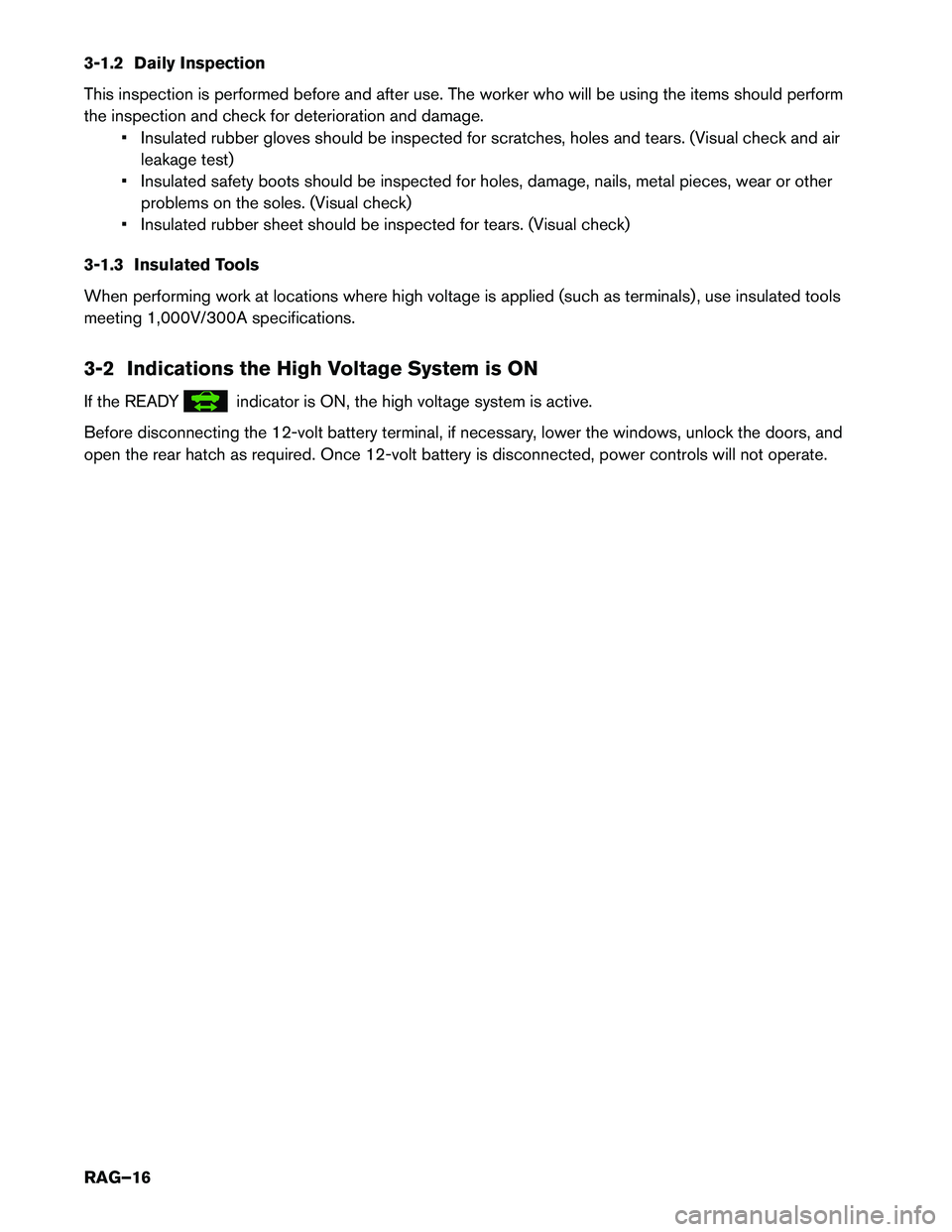
3-1.2 Daily Inspection
This inspection is performed before and after use. The worker who will be using the items should perform
the inspection and check for deterioration and damage.• Insulated rubber gloves should be inspected for scratches, holes and tears. (Visual check and airleakage test)
• Insulated safety boots should be inspected for holes, damage, nails, metal pieces, wear or other problems on the soles. (Visual check)
• Insulated rubber sheet should be inspected for tears. (Visual check)
3-1.3 Insulated Tools
When performing work at locations where high voltage is applied (such as terminals) , use insulated tools
meeting 1,000V/300A specifications.
3-2 Indications the High Voltage System is ON
If the READY
indicator is ON, the high voltage system is active.
Before disconnecting the 12-volt battery terminal, if necessary, lower the windows, unlock the doors, and
open the rear hatch as required. Once 12-volt battery is disconnected, power controls will not operate. RAG–16
Page 17 of 36
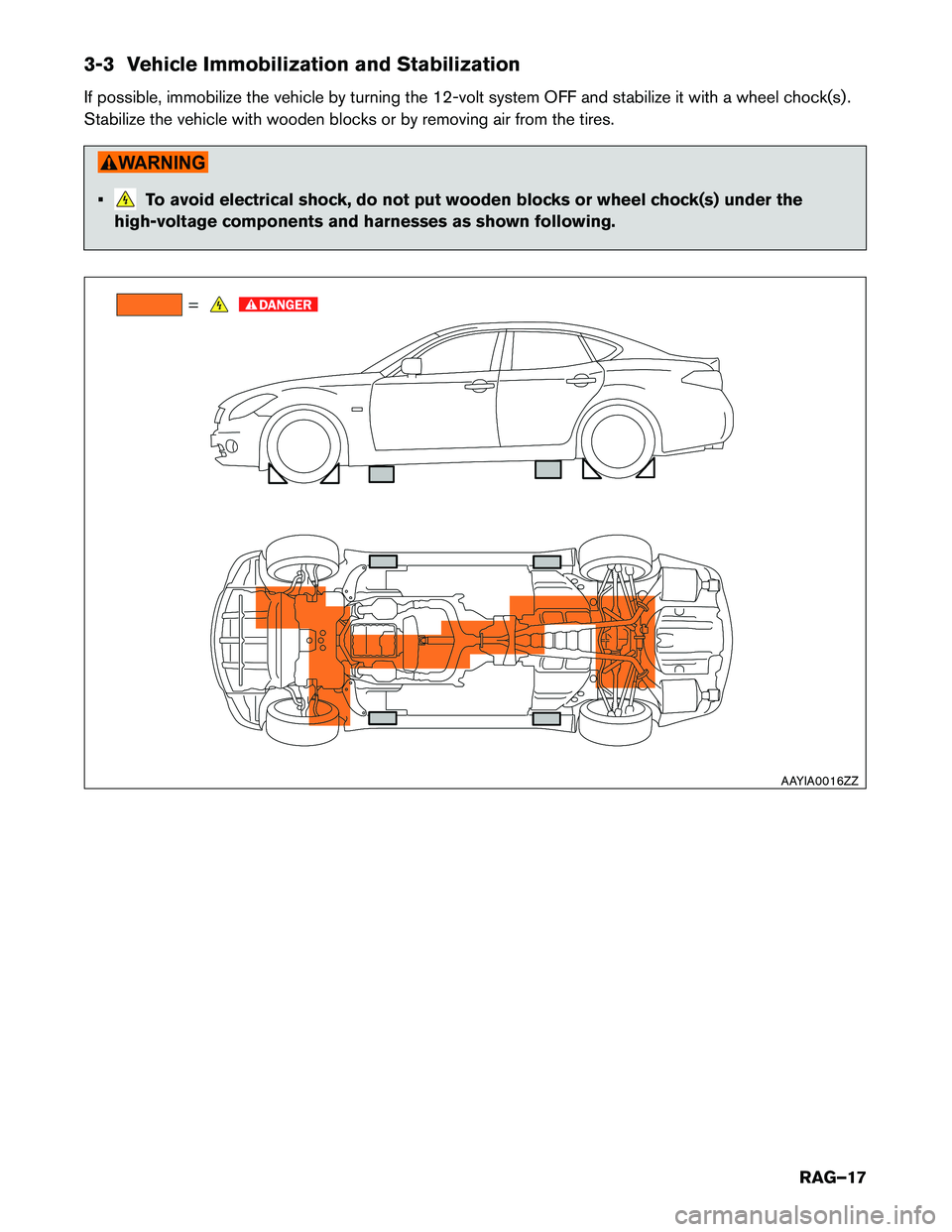
3-3 Vehicle Immobilization and Stabilization
If possible, immobilize the vehicle by turning the 12-volt system OFF and stabilize it with a wheel chock(s) .
Stabilize the vehicle with wooden blocks or by removing air from the tires.
•To avoid electrical shock, do not put wooden blocks or wheel chock(s) under the
high-voltage components and harnesses as shown following.
AAYIA0016ZZ
RAG–17
Page 18 of 36
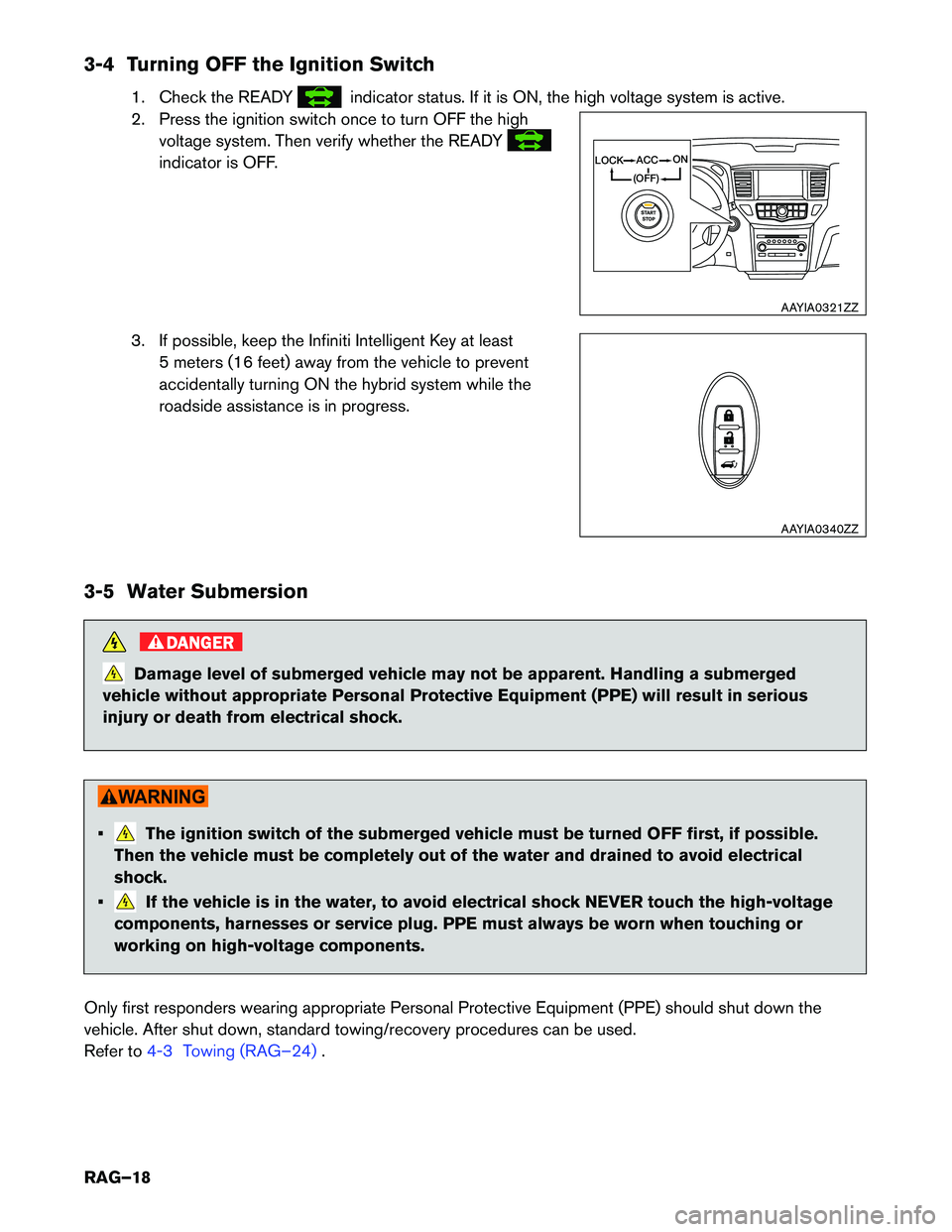
3-4 Turning OFF the Ignition Switch1. Check the READY
indicator status. If it is ON, the high voltage system is active.
2. Press the ignition switch once to turn OFF the high voltage system. Then verify whether the READY
indicator is OFF.
3. If possible, keep the Infiniti Intelligent Key at least 5 meters (16 feet) away from the vehicle to prevent
accidentally turning ON the hybrid system while the
roadside assistance is in progress.
3-5 Water Submersion
DANGER
Damage level of submerged vehicle may not be apparent. Handling a submerged
vehicle without appropriate Personal Protective Equipment (PPE) will result in serious
injury or death from electrical shock.
•The ignition switch of the submerged vehicle must be turned OFF first, if possible.
Then the vehicle must be completely out of the water and drained to avoid electrical shock.
•
If the vehicle is in the water, to avoid electrical shock NEVER touch the high-voltage
components, harnesses or service plug. PPE must always be worn when touching or
working on high-voltage components.
Only first responders wearing appropriate Personal Protective Equipment (PPE) should shut down the
vehicle. After shut down, standard towing/recovery procedures can be used.
Refer to
4-3 Towing (RAG–24).
ACC
LOCK
(OFF)
ON
AAYIA0321ZZ
AAYIA0340ZZ
RAG–18
Page 23 of 36
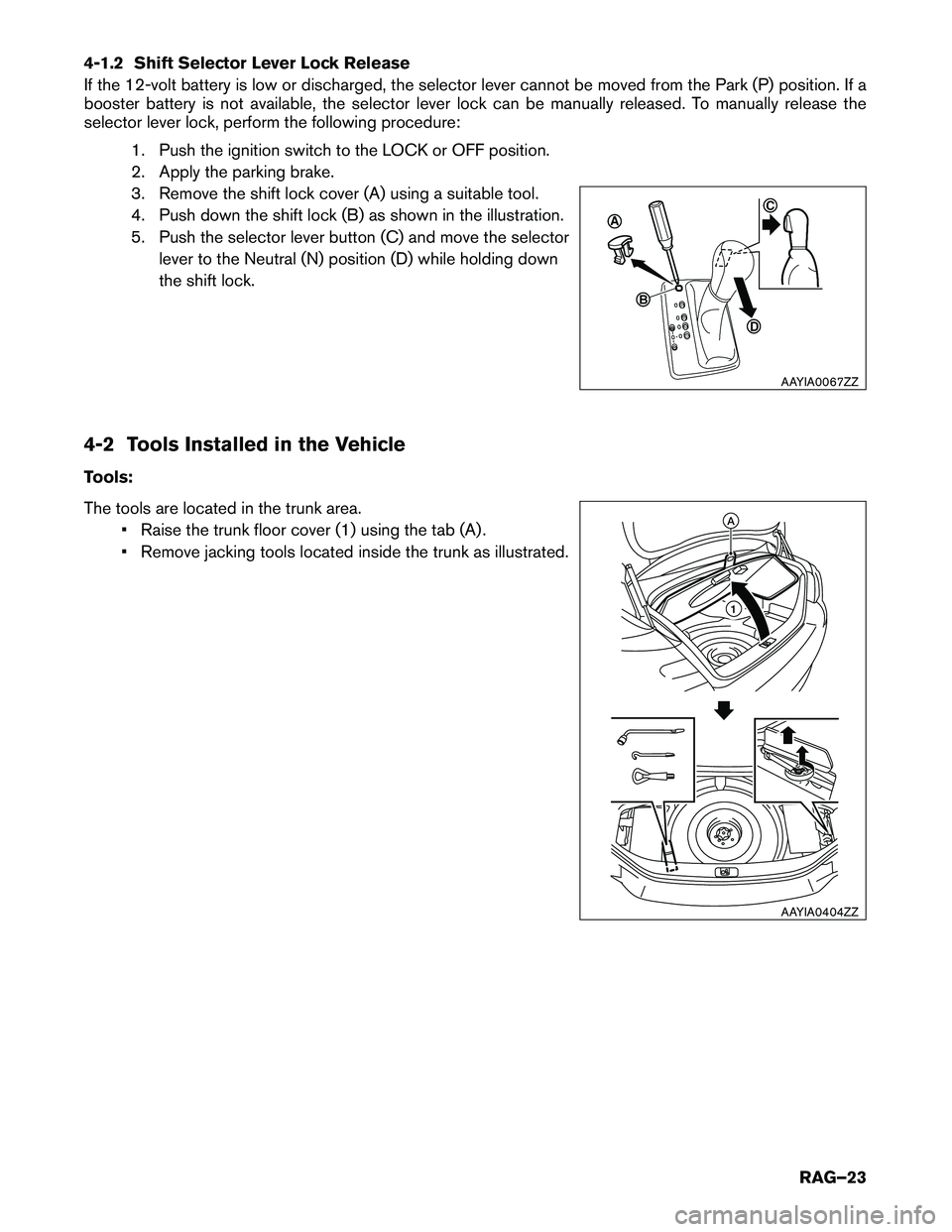
4-1.2 Shift Selector Lever Lock Release
If the 12-volt battery is low or discharged, the selector lever cannot be moved from the Park (P) position. If a
booster battery is not available, the selector lever lock can be manually released. To manually release the
selector lever lock, perform the following procedure:1. Push the ignition switch to the LOCK or OFF position.
2. Apply the parking brake.
3. Remove the shift lock cover (A) using a suitable tool.
4. Push down the shift lock (B) as shown in the illustration.
5. Push the selector lever button (C) and move the selectorlever to the Neutral (N) position (D) while holding down
the shift lock.
4-2 Tools Installed in the Vehicle
Tools:
The tools are located in the trunk area. • Raise the trunk floor cover (1) using the tab (A) .
• Remove jacking tools located inside the trunk as illustrated.
AAYIA0067ZZ
A
1
AAYIA0404ZZ
RAG–23
Page 25 of 36
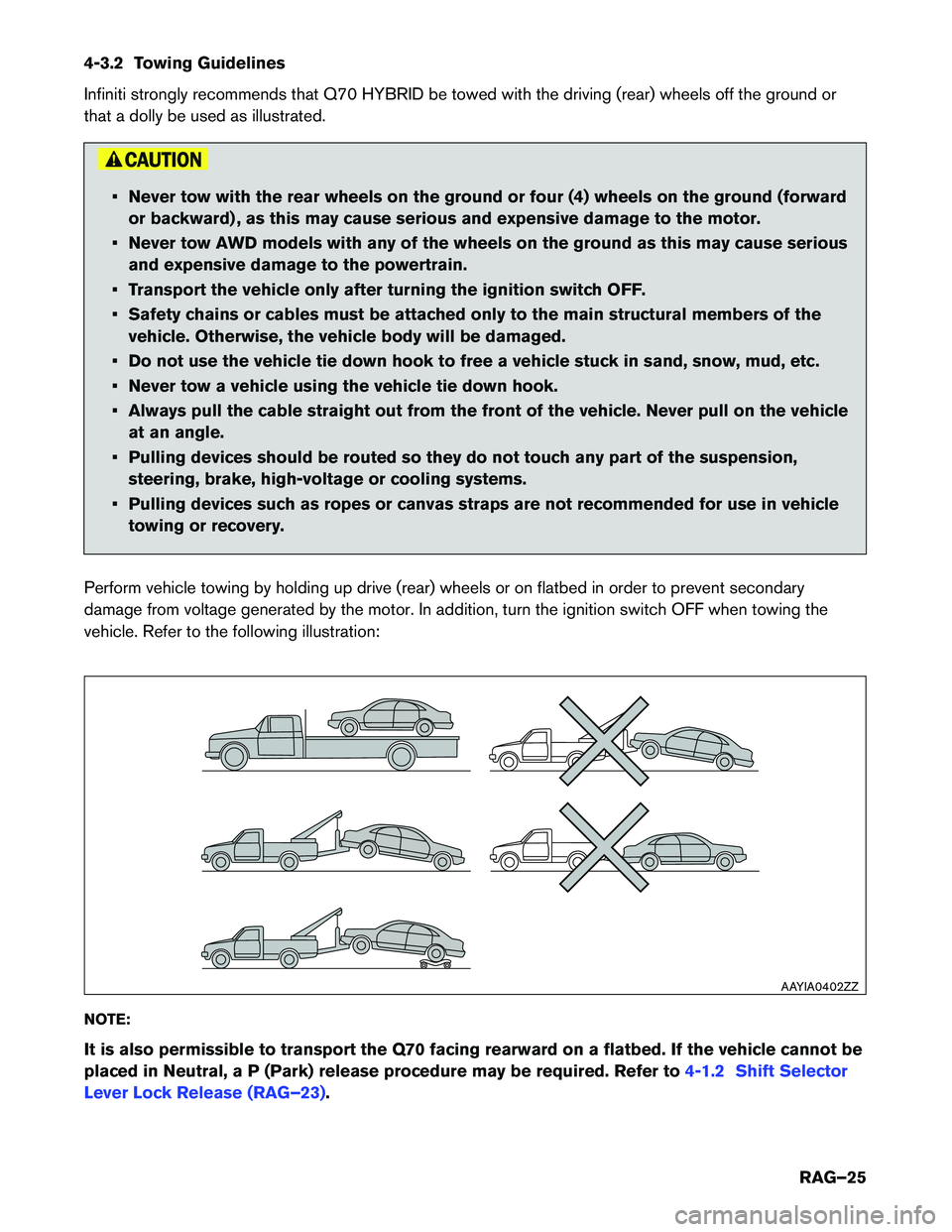
4-3.2 Towing Guidelines
Infiniti strongly recommends that Q70 HYBRID be towed with the driving (rear) wheels off the ground or
that a dolly be used as illustrated.
• Never tow with the rear wheels on the ground or four (4) wheels on the ground (forwardor backward) , as this may cause serious and expensive damage to the motor.
• Never tow AWD models with any of the wheels on the ground as this may cause serious and expensive damage to the powertrain.
• Transport the vehicle only after turning the ignition switch OFF.
• Safety chains or cables must be attached only to the main structural members of the vehicle. Otherwise, the vehicle body will be damaged.
• Do not use the vehicle tie down hook to free a vehicle stuck in sand, snow, mud, etc.
• Never tow a vehicle using the vehicle tie down hook.
• Always pull the cable straight out from the front of the vehicle. Never pull on the vehicle at an angle.
• Pulling devices should be routed so they do not touch any part of the suspension, steering, brake, high-voltage or cooling systems.
• Pulling devices such as ropes or canvas straps are not recommended for use in vehicle towing or recovery.
Perform vehicle towing by holding up drive (rear) wheels or on flatbed in order to prevent secondary
damage from voltage generated by the motor. In addition, turn the ignition switch OFF when towing the
vehicle. Refer to the following illustration:
NOTE:
It is also permissible to transport the Q70 facing rearward on a flatbed. If the vehicle cannot be
placed in Neutral, a P (Park) release procedure may be required. Refer to
4-1.2 Shift Selector
Lever Lock Release (RAG–23)
.
AAYIA0402ZZ
RAG–25
Page 27 of 36
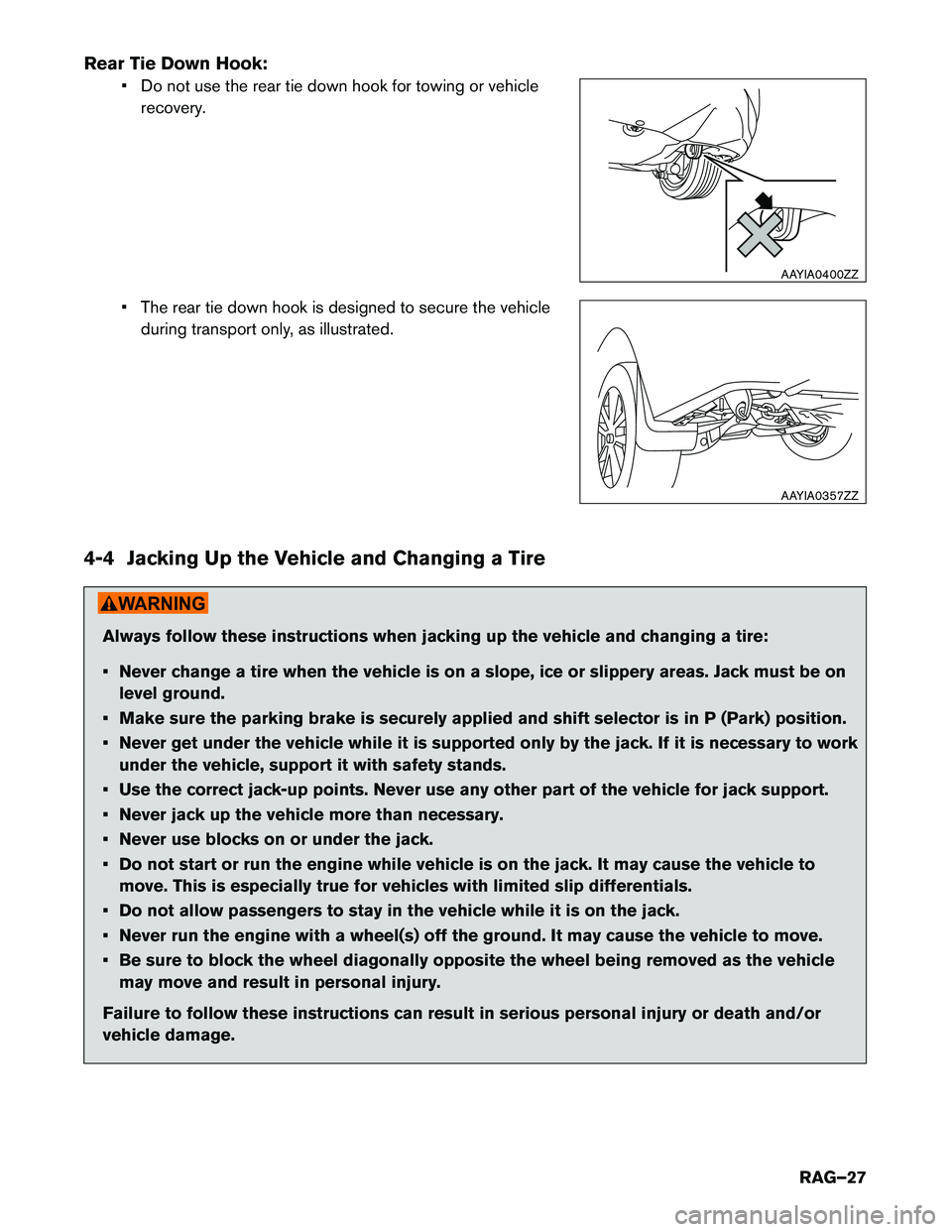
Rear Tie Down Hook:• Do not use the rear tie down hook for towing or vehiclerecovery.
• The rear tie down hook is designed to secure the vehicle during transport only, as illustrated.
4-4 Jacking Up the Vehicle and Changing a Tire
Always follow these instructions when jacking up the vehicle and changing a tire:
• Never change a tire when the vehicle is on a slope, ice or slippery areas. Jack must be on level ground.
• Make sure the parking brake is securely applied and shift selector is in P (Park) position.
• Never get under the vehicle while it is supported only by the jack. If it is necessary to work under the vehicle, support it with safety stands.
• Use the correct jack-up points. Never use any other part of the vehicle for jack support.
• Never jack up the vehicle more than necessary.
• Never use blocks on or under the jack.
• Do not start or run the engine while vehicle is on the jack. It may cause the vehicle to move. This is especially true for vehicles with limited slip differentials.
• Do not allow passengers to stay in the vehicle while it is on the jack.
• Never run the engine with a wheel(s) off the ground. It may cause the vehicle to move.
• Be sure to block the wheel diagonally opposite the wheel being removed as the vehicle may move and result in personal injury.
Failure to follow these instructions can result in serious personal injury or death and/or
vehicle damage.
AAYIA0400ZZ
AAYIA0357ZZ
RAG–27
Page 28 of 36
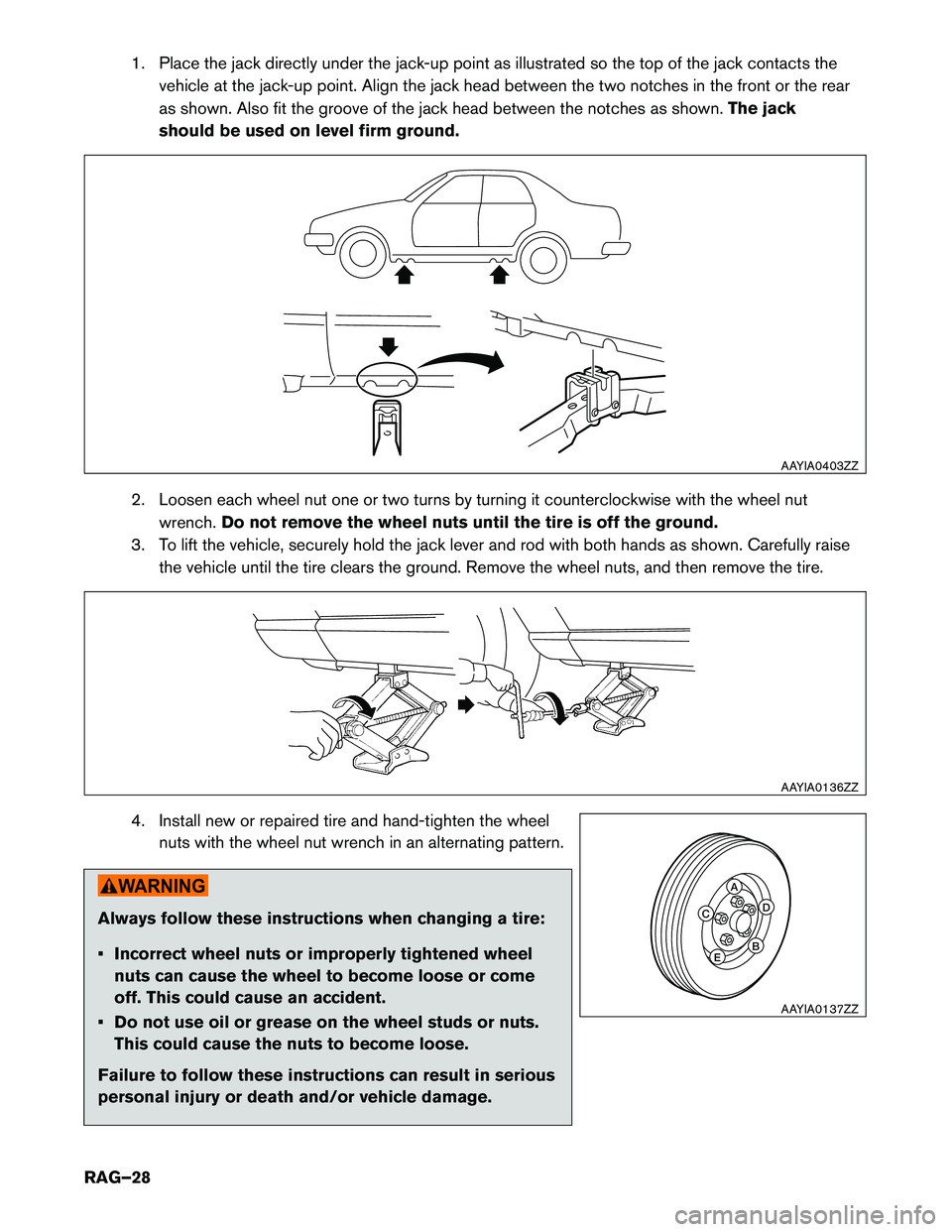
1. Place the jack directly under the jack-up point as illustrated so the top of the jack contacts thevehicle at the jack-up point. Align the jack head between the two notches in the front or the rear
as shown. Also fit the groove of the jack head between the notches as shown. The jack
should be used on level firm ground.
2. Loosen each wheel nut one or two turns by turning it counterclockwise with the wheel nut wrench. Do not remove the wheel nuts until the tire is off the ground.
3. To lift the vehicle, securely hold the jack lever and rod with both hands as shown. Carefully raise the vehicle until the tire clears the ground. Remove the wheel nuts, and then remove the tire.
4. Install new or repaired tire and hand-tighten the wheel nuts with the wheel nut wrench in an alternating pattern.
Always follow these instructions when changing a tire:
• Incorrect wheel nuts or improperly tightened wheelnuts can cause the wheel to become loose or come
off. This could cause an accident.
• Do not use oil or grease on the wheel studs or nuts. This could cause the nuts to become loose.
Failure to follow these instructions can result in serious
personal injury or death and/or vehicle damage.
AAYIA0403ZZ
AAYIA0136ZZ
BE
CD
A
AAYIA0137ZZ
RAG–28
Page 32 of 36
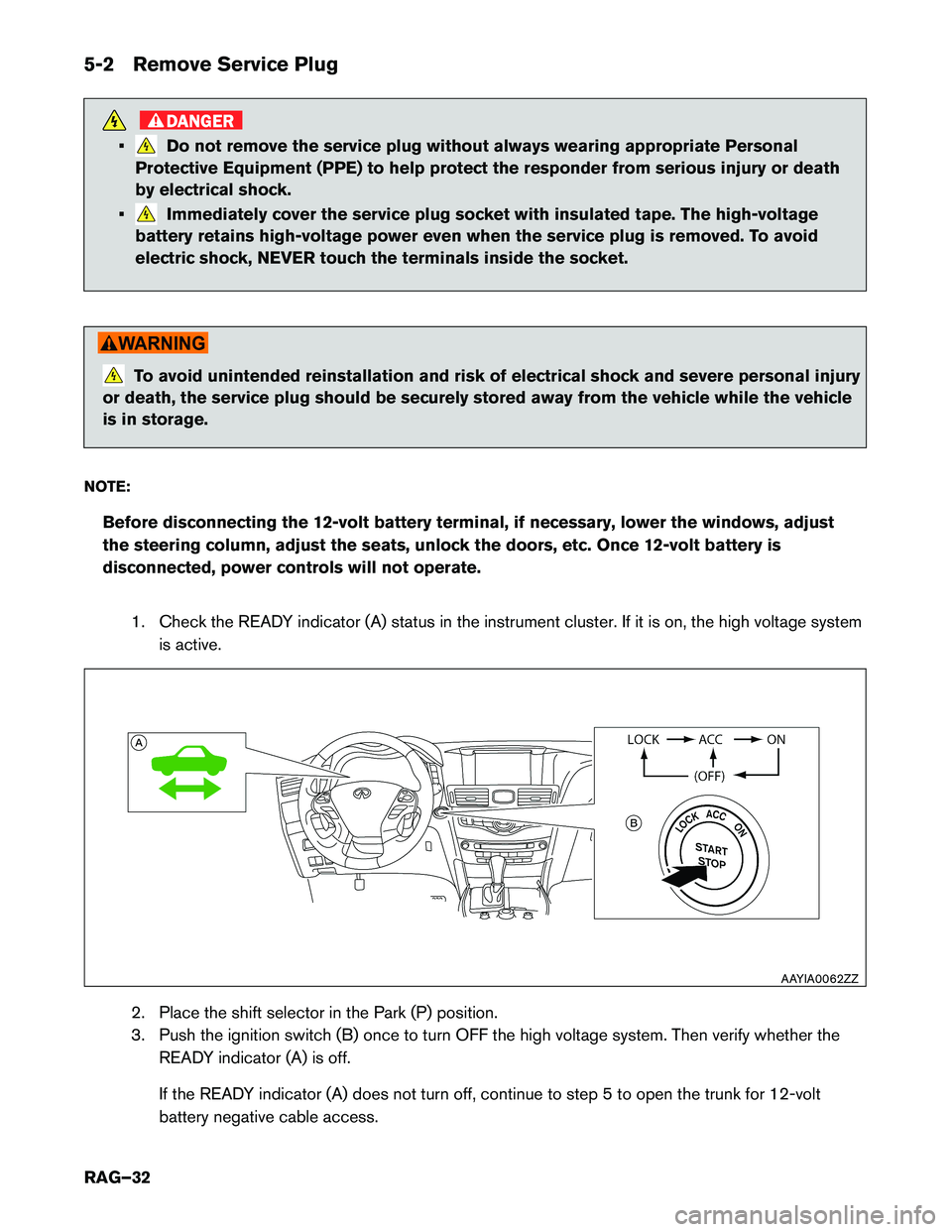
5-2 Remove Service Plug
DANGER
•Do not remove the service plug without always wearing appropriate Personal
Protective Equipment (PPE) to help protect the responder from serious injury or death
by electrical shock.
•
Immediately cover the service plug socket with insulated tape. The high-voltage
battery retains high-voltage power even when the service plug is removed. To avoid
electric shock, NEVER touch the terminals inside the socket.
To avoid unintended reinstallation and risk of electrical shock and severe personal injury
or death, the service plug should be securely stored away from the vehicle while the vehicle
is in storage.
NOTE: Before disconnecting the 12-volt battery terminal, if necessary, lower the windows, adjust
the steering column, adjust the seats, unlock the doors, etc. Once 12-volt battery is
disconnected, power controls will not operate.
1. Check the READY indicator (A) status in the instrument cluster. If it is on, the high voltage systemis active.
2. Place the shift selector in the Park (P) position.
3. Push the ignition switch (B) once to turn OFF the high voltage system. Then verify whether the READY indicator (A) is off.
If the READY indicator (A) does not turn off, continue to step 5 to open the trunk for 12-volt
battery negative cable access.
AAYIA0062ZZ
RAG–32
Page 34 of 36

6. Open the 12-volt battery service access cover (G) .
7. Disconnect negative (-) battery cable (H) and cover it with insulated tape.
8. Open service plug access cover (J) .
9. Remove the service plug (K) by pressing the locking tab (L) and rotating the handle (M) fullyoutward (N) . Using the handle, pull the service plug (P) completely out of its socket.
HOLD
C
D
L
MN
P
E
F
K
J
GH
AAYIA0360ZZ
RAG–34